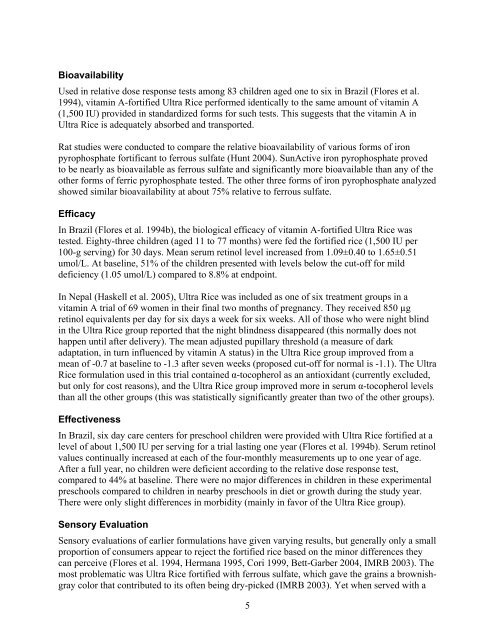The Research Behind the Ultra Rice® Technology - Path
The Research Behind the Ultra Rice® Technology - Path
The Research Behind the Ultra Rice® Technology - Path
Create successful ePaper yourself
Turn your PDF publications into a flip-book with our unique Google optimized e-Paper software.
Bioavailability<br />
Used in relative dose response tests among 83 children aged one to six in Brazil (Flores et al.<br />
1994), vitamin A-fortified <strong>Ultra</strong> Rice performed identically to <strong>the</strong> same amount of vitamin A<br />
(1,500 IU) provided in standardized forms for such tests. This suggests that <strong>the</strong> vitamin A in<br />
<strong>Ultra</strong> Rice is adequately absorbed and transported.<br />
Rat studies were conducted to compare <strong>the</strong> relative bioavailability of various forms of iron<br />
pyrophosphate fortificant to ferrous sulfate (Hunt 2004). SunActive iron pyrophosphate proved<br />
to be nearly as bioavailable as ferrous sulfate and significantly more bioavailable than any of <strong>the</strong><br />
o<strong>the</strong>r forms of ferric pyrophosphate tested. <strong>The</strong> o<strong>the</strong>r three forms of iron pyrophosphate analyzed<br />
showed similar bioavailability at about 75% relative to ferrous sulfate.<br />
Efficacy<br />
In Brazil (Flores et al. 1994b), <strong>the</strong> biological efficacy of vitamin A-fortified <strong>Ultra</strong> Rice was<br />
tested. Eighty-three children (aged 11 to 77 months) were fed <strong>the</strong> fortified rice (1,500 IU per<br />
100-g serving) for 30 days. Mean serum retinol level increased from 1.09±0.40 to 1.65±0.51<br />
umol/L. At baseline, 51% of <strong>the</strong> children presented with levels below <strong>the</strong> cut-off for mild<br />
deficiency (1.05 umol/L) compared to 8.8% at endpoint.<br />
In Nepal (Haskell et al. 2005), <strong>Ultra</strong> Rice was included as one of six treatment groups in a<br />
vitamin A trial of 69 women in <strong>the</strong>ir final two months of pregnancy. <strong>The</strong>y received 850 μg<br />
retinol equivalents per day for six days a week for six weeks. All of those who were night blind<br />
in <strong>the</strong> <strong>Ultra</strong> Rice group reported that <strong>the</strong> night blindness disappeared (this normally does not<br />
happen until after delivery). <strong>The</strong> mean adjusted pupillary threshold (a measure of dark<br />
adaptation, in turn influenced by vitamin A status) in <strong>the</strong> <strong>Ultra</strong> Rice group improved from a<br />
mean of -0.7 at baseline to -1.3 after seven weeks (proposed cut-off for normal is -1.1). <strong>The</strong> <strong>Ultra</strong><br />
Rice formulation used in this trial contained -tocopherol as an antioxidant (currently excluded,<br />
but only for cost reasons), and <strong>the</strong> <strong>Ultra</strong> Rice group improved more in serum -tocopherol levels<br />
than all <strong>the</strong> o<strong>the</strong>r groups (this was statistically significantly greater than two of <strong>the</strong> o<strong>the</strong>r groups).<br />
Effectiveness<br />
In Brazil, six day care centers for preschool children were provided with <strong>Ultra</strong> Rice fortified at a<br />
level of about 1,500 IU per serving for a trial lasting one year (Flores et al. 1994b). Serum retinol<br />
values continually increased at each of <strong>the</strong> four-monthly measurements up to one year of age.<br />
After a full year, no children were deficient according to <strong>the</strong> relative dose response test,<br />
compared to 44% at baseline. <strong>The</strong>re were no major differences in children in <strong>the</strong>se experimental<br />
preschools compared to children in nearby preschools in diet or growth during <strong>the</strong> study year.<br />
<strong>The</strong>re were only slight differences in morbidity (mainly in favor of <strong>the</strong> <strong>Ultra</strong> Rice group).<br />
Sensory Evaluation<br />
Sensory evaluations of earlier formulations have given varying results, but generally only a small<br />
proportion of consumers appear to reject <strong>the</strong> fortified rice based on <strong>the</strong> minor differences <strong>the</strong>y<br />
can perceive (Flores et al. 1994, Hermana 1995, Cori 1999, Bett-Garber 2004, IMRB 2003). <strong>The</strong><br />
most problematic was <strong>Ultra</strong> Rice fortified with ferrous sulfate, which gave <strong>the</strong> grains a brownishgray<br />
color that contributed to its often being dry-picked (IMRB 2003). Yet when served with a<br />
5
















